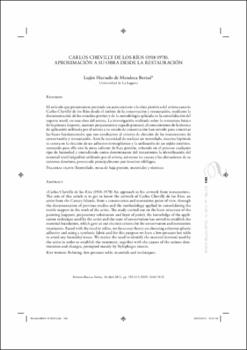Carlos Chevilly de los Ríos (1918-1978). Aproximación a su obra desde la restauración
Fecha
2012Resumen
El artículo que presentamos pretende un acercamiento a la obra pictórica del artista canario
Carlos Chevilly de los Ríos desde el ámbito de la conservación y restauración, mediante la
documentación de los estudios previos y de la metodología aplicada en la consolidación del
soporte textil, en una obra del artista. La investigación realizada sobre la estructura básica
de la pintura (soporte, sustrato preparatorio y capa de pintura), el conocimiento de la técnica
de aplicación utilizada por el artista y su estado de conservación han servido para concretar
las bases fundamentales que nos condujeron al criterio de elección de los tratamientos de
conservación y restauración. Ante la necesidad de realizar un reentelado, nuestra hipótesis
se centra en la elección de un adhesivo termoplástico y la utilización de un tejido sintético,
contando para ello con la mesa caliente de baja presión, evitando en el proceso cualquier
tipo de humedad y entendiendo como determinante del tratamiento la identifi cación del
material textil (algodón) utilizado por el artista, así como las causas y las alteraciones de su
extremo deterioro, provocado principalmente por insectos xilófagos. Th e aim of this article is to get to know the artwork of Carlos Chevilly de los Ríos, an
artist from the Canary Islands, from a conservation and restoration point of view, through
the documentation of previous studies and the methodology applied in consolidating the
textile support in the work of the artist. Th e study carried out on the basic structure of the
painting (support, preparatory substratum and layer of paint), the knowledge of the application
technique used by the artist and the state of conservation has served to establish the
essential foundation, which gave us our election criteria for the conservation and restoration
treatments. Faced with the need to reline, we focus our theory on choosing a thermo-plastic
adhesive and using a synthetic fabric and for this purpose we have a low-pressure hot table
to avoid any humidity issues. We realise the need to identify the material (cotton) used by
the artist in order to establish the treatment, together with the causes of the serious deterioration
and changes, prompted mainly by Xylophages insects.





